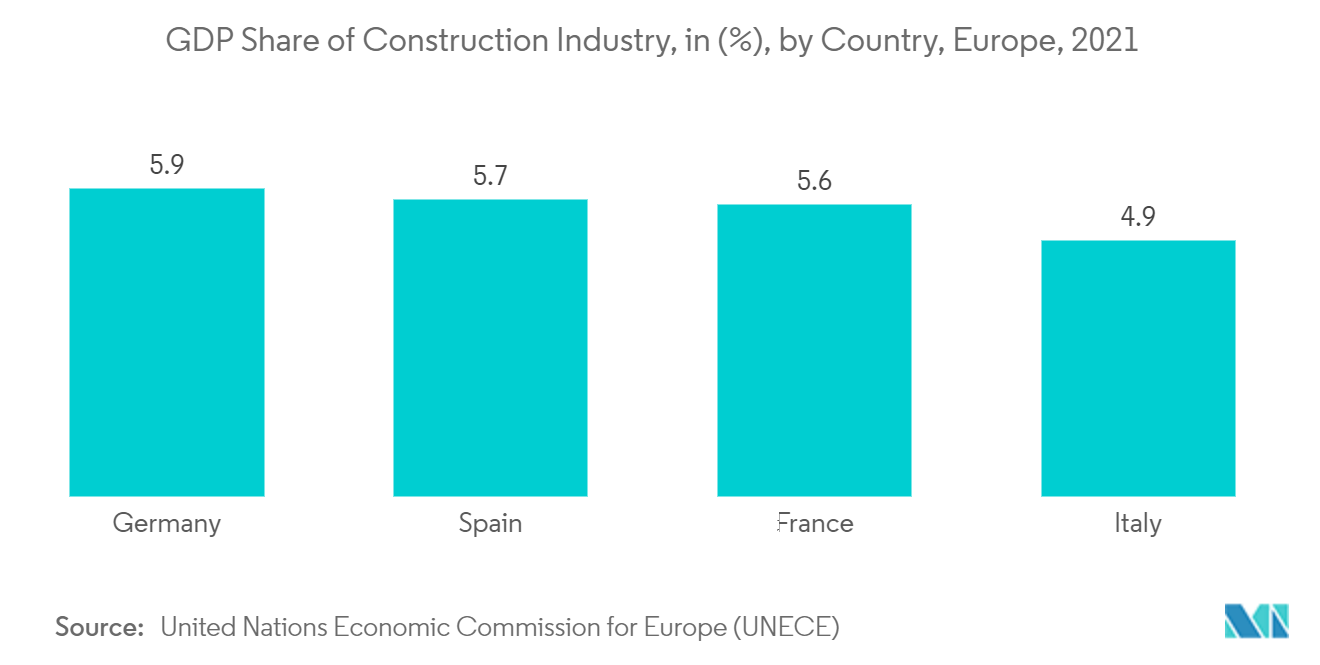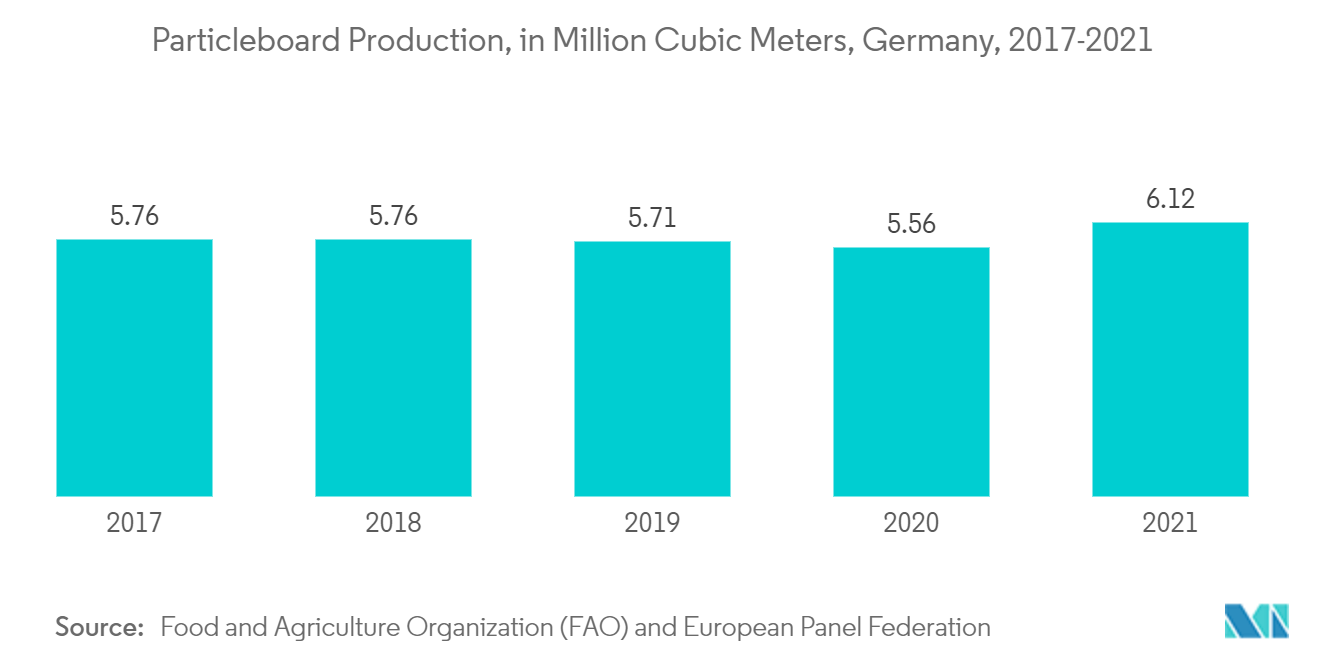Market Trends of Europe Particle Board Industry
This section covers the major market trends shaping the Europe Particle Board Market according to our research experts:
Growing Demand in the Construction Sector
- Particle boards are used to construct the interiors of buildings, such as floors, partitions, wall paneling, faux ceiling, and shelving, owing to their advantages, such as their lightweight, low cost, ease of installation, and thermo-acoustic insulation qualities. As particle board is made from scrap timber, it is both environmentally beneficial and less expensive than plywood.
- Rising construction activities, combined with a greater emphasis on home interior design, are promoting particle board demand in a variety of applications, such as flooring material. They serve as a base for parquet, wood, and carpeted floors.
- According to the United Nations Economic Commission for Europe (UNECE), Germany has the largest GDP share of 5.90% in the construction industry compared to Spain, France, and Italy.
- The European construction industry has been steadily growing in recent years due to increased infrastructural spending. Germany boasts of hosting Europe's largest construction industry. The country's construction industry has been developing slowly, primarily due to increased new residential construction operations.
- Furthermore, according to the Federal Statistical Office (Destatis), the building comprising nearly 32,384 houses was approved in Germany in May 2021, an increase of 8.7% from April 2021. Most European countries' construction sectors account for 4-7% of their GDP in 2021.
- Furthermore, the government of the United Kingdom proposes to invest GBP 23 billion (USD 27.69 billion) in housing, science and innovation, transportation, and a 5G network over the next five years under the Northern Powerhouse Investment Fund (NPIF). Around GBP 7.2 billion (USD 9.51 billion) is set aside for new housing buildings, with another GBP 4 billion (USD 4.82 billion) set aside for infrastructure.
- The government's investment of GBP 100 billion (USD 120.63 billion) in large-scale housing and regeneration projects, as well as vital social infrastructures, such as schools, hospitals, and prisons, is expected to boost the demand for engineering particle boards from construction activities.
- Several construction firms believe that office space in Europe has a promising future, so they have undertaken commercial construction projects.
- Europe is experiencing a retail expansion, with new malls being built all over the continent. Some of the most recent European developments are the Metropol Mall in Turkey, Vegas Kuntsevo in Russia, Mall of Scandinavia in Sweden, Westfield Bradford in the United Kingdom, Weberzeile Ried in Austria, Mall of Europe in Belgium, and Lublin Mall in Poland.
- The French government has begun the preliminary preparations for hosting the 2024 Olympics. For instance, the French government has approved a total of around USD 3.3 billion for the construction of the Hermitage towers (two 320-meter-1050-foot structures) scheduled for completion in 2024.
- The required infrastructure for the Olympic event necessitates the construction of 4,500 new homes for locals, 100,000 square meters for business activity, and 20,000 new hotel rooms for guests.
- All the aforementioned factors are expected to drive construction activity in both developing and developed countries, which is likely to benefit the particle board market during the forecast period.

Germany is Anticipated to Hold a Major Share of Europe
- Germany dominates the particle board market in terms of market share and market revenue. The region is set to continue to flourish in its dominance over the forecast period.
- According to the European Panel Federation, particleboard production volume in Germany accounted for 6.12 million cubic meters in 2021. Further, in 2020, as per Food and Agriculture Organization (FAO), the particleboard production volume in the country accounted for 5.56 million cubic meters.
- Construction contributes 11% of the overall industrial output. The strong performance of the construction sector will stimulate the demand for wood for construction applications. German construction firms are profiting from the rising real estate demand, increased building investments, and increased government infrastructure spending.
- Over the last five years, the European Central Bank's ultra-low lending rates, growing urban population, and significant immigration have all contributed to the construction boom. The sector is contributing to overall economic growth.
- The construction-related sector, which accounts for 16% of the timber industry, is the second-largest segment, after prefabricated building. Manufacturers of windows, doors, staircases, and other wood-based components raised their sales by more than 3% in the previous year. These variables are predicted to have an impact on the country's particle board market demand.
- The German government announced a goal to build approximately 1.5 million dwelling units by 2021. The backlog of pending residential building permits has surpassed 400,000, indicating that the sector may continue to drive expansion.
- According to the new government's plans for 2021, social investments will be made in the construction of 400,000 affordable housing units over the next few years. The country's rising migration has boosted the demand for new residential buildings.
- Germany has the European Union's largest furniture market. According to the German Furniture Industry Association (VDM), the furniture industry increased by 17% in the first nine months of 2021, accounting for EUR 6.2 billion.
- The furniture market is an important sector in the German economy, accounting for approximately 7% of the entire German consumer goods market. The strong purchasing power of consumers provides a chance for producers to innovate.
- Thus, all the above-mentioned factors are likely to provide the increasing demand for the European particle board market during the forecast period.

